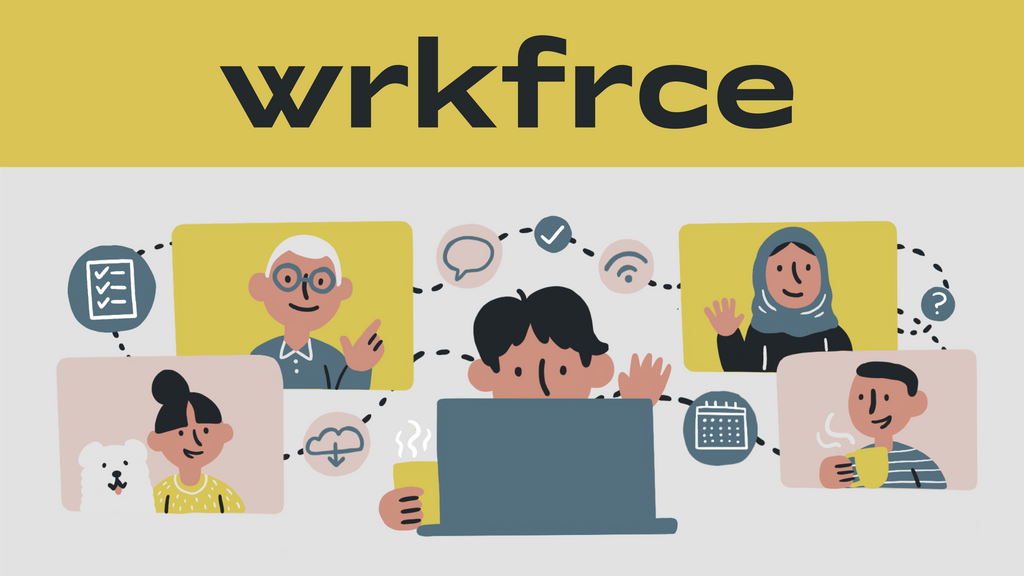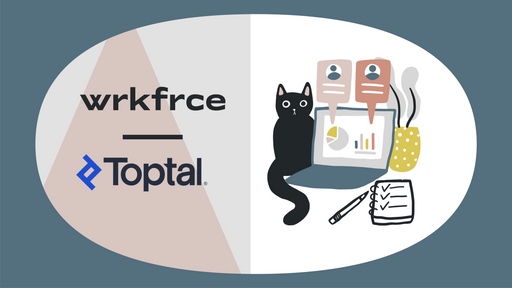wrkfrce Playbook Project: How to Communicate and Collaborate as a Remote Team
by Sarah Archer

To complement our summaries of playbooks by leading remote-first companies, digital nomad Sarah Archer has put together a three-part thematic series covering everything current—and aspiring—remote businesses need to know about how to hire the best employees, collaborate with a team, and build a rock-solid company culture for even the most distributed of staff.
A company’s communication strategy is what helps them grow a team of highly-productive employees, and will ultimately lead them to strong outcomes quarter after quarter. When you working remotely, there’s no bumping into your colleague in the kitchen or walking over to their desk to discuss plans. Remote teams must put even more emphasis on how their team communicates and collaborates, because, let’s face it, a carefully planned communication strategy (or lack thereof) will make or break a remote team.
After spending hours reading top remote company playbooks from front to back and tapping experts in the world of remote work, we’ve identified the following best practices for effectively communicating and collaborating as a remote team.
Embrace Asynchronous Communication
Asynchronous communication, or communication that doesn’t expect an immediate response, is key for remote companies. It supports the notion that work doesn’t happen at the same time for everyone, whether that’s due to different time zones or to teammates’ varying optimal work times.
When working asynchronously, teams should plan ahead. Given that you don’t expect an immediate response, you shouldn’t make decisions last-minute.
Asynchronous communication also supports a healthy work-life balance. Since employees won’t feel obligated to respond to messages or emails at all times, they can enjoy their time outside work without distractions.
To put asynchronous communication into practice, teams should define what is expected of their members: in what time frame they should respond to email, when they should document a new takeaway (hint: almost always), and when they should turn to instant messaging, versus email.
Design Meetings to Be Efficient and Purposeful
If your calendar is full of weekly meetings without rhyme or reason, your team’s productive time is going down the drain. Imagine you have a team of eight people who meet once per week for one hour. You don’t accomplish much in the meeting, but it’s been on your calendar for months (or even years). That’s eight hours of potentially productive time lost. Take a hard look at your schedule and determine if you can condense—or even scrap—any of your meetings. And follow these tips to accomplish the most out of your remote meetings.
Designate a Meeting Leader
All meetings should start with the point person—who’s in charge of the invite, agenda, speaking, and note taking?
The meeting leader should make sure that all meetings are established to collaborate, connect with team members, and make decisions. They should lead the meetings to accomplish these goals and delegate tasks as they see fit.
Ensure That All Meetings Have an Agenda
All of your meetings should start with an agenda that every participant can contribute to. Not only will it help you stay organized and cognizant of everyone’s time, but it will ensure that every voice is heard, even if some people don’t feel comfortable speaking in front of the group.
Create an agenda template in Google Docs to easily replicate the format for every meeting, and share it among the team one day before the scheduled meeting. That will give everyone a chance to contribute talking points, and for you to determine if the meeting is even necessary.
Add a link to the agenda to the meeting invite and take notes of the action items during the call, so no one misses the key takeaways.
Offer the Means to a Great Video Call
When you engage in a remote video meeting, you’re inviting your colleagues into your home. Some people might curate their backdrop, while others might be embarrassed by their background and situate themselves in front of a blank wall. Be cognizant of different life circumstances and allow employees to create a work space and background that makes them feel most comfortable.
Despite background differences, don’t expect employees to invest their budget in the ideal setup; offer a remote work space stipend that supports employees’ video conference potential. Cover headphones, a Krisp membership, an external camera and microphone, and even internet bills. Do what you can to alleviate the burden on your employees. Not only will meetings run more smoothly, but your employees will feel more valued at work.
Show That You Care About the People
Similar to how you’d act in an office setting, meetings don’t have to be all about business. All meetings should kick off with 5–10 minutes of small talk and asking questions—about each other’s weekends, vacation plans, or anything unique to your relationship with the other participants.
Establish a Level Playing Field
If you’ve experienced it, you know what entering a meeting remotely while everyone else is in an office feels like. You hear jokes and chatter in the background but aren’t sure when to step in.
Avoid letting that happen altogether by introducing an all-or-nothing approach to videoconferencing. If one person in the meeting is alone on-screen, everyone should be—even if the other participants are all in a room together, they should each open their own individual screen to ensure a consistent visual presence among all attendees.
Be Aware of Time Zones
One of the great benefits of hiring remotely means you have access to the best talent in the world. But that also means that they could be located in an entirely different time zone.
If you have team members in different time zones, rotate your meetings schedule so that everyone can experience an optimal meeting time. Use Every Time Zone to understand what overlap you have to work with.
Another way you can combat confusion is by ensuring a 3-to-4-hour overlap and holding meetings within that time frame. That way, everyone on the team knows that they can get ahold of their team member during that time, regardless of where anyone is located.
Press Record
Team members will inevitably have to miss calls from time to time. Record your meetings so that those who missed out can follow along when it’s convenient to them, and so you can refer back to the conversation if you forgot a key component that you omitted from your notes.
Sometimes you can even bypass a meeting altogether by using Loom, a video-messaging tool that allows you to have conversations that don’t need to happen in real time.
Provide Constructive Feedback in One-on-Ones
When you give constructive feedback over email, it’s difficult to know how your direct report received it. Maybe they disagree with the feedback or think their job security is at stake. Always provide feedback over video in a one-on-one meeting so you can make your input clear and can read your direct reports’ nonverbal cues correctly.
Finally, stay aware of your body language on the call. As with an in-person meeting, your demeanor can affect other participants. Remain engaged, smile, and avoid fidgeting to show that you care about everyone’s input on the call.
Document Everything. We Mean Everything.
Every team has its own unique principles and ideals. But one thing about these playbooks is consistent: Everything must be documented.
All decisions and road maps should be communicated on paper (or, rather, the cloud) to ensure that everyone is on the same page (pardon the pun).
Write a Modifiable Remote Playbook
There’s a reason why top distributed companies write their playbooks. It’s an investment that will save time, increase productivity, and keep your entire remote team on the same page.
Organize yours with a table of contents, and include all important internal and external links. Cover everything from how to submit reimbursement or request vacation to how meetings should be held and how to maintain a healthy work-life balance.
There’s a reason why we use the term “modifiable.” No playbook is set in stone, as processes and ideas will constantly improve and take a new shape. Maybe a new team member has a better recommendation for a collaboration tool, or a more senior member thinks an established weekly meeting can be moved to biweekly. Everyone in your company should have a voice and input in your remote playbook.
Disclose Individual and Company-Wide Goals
Transparency is crucial in a remote environment.
That’s why it’s important to publicly share everyone’s objectives and key results. For example, if your company-wide goal is to increase sales by 25 percent next quarter, create and share goals about how every employee will help the company get there, regardless of what department they’re in.
Schedule File Purges and Organization Blocks
Regardless of how organized you are, you’ve no doubt lost something in a deep folder at some point. And when remote teams save all their work on the cloud, things can get messy.
Block out time once per quarter to organize files and delete any unnecessarily large ones. Encourage all staff to do the same, and to move any files living on their local drive to your cloud-based solutions so they have backups.
Offer Mentorship
Connect all employees with a mentor from day one. That point person can help with onboarding and career growth by answering questions, providing feedback, or helping their mentee identify or meet career goals.
Mentors should set aside a meeting at least once a month to talk about the progress mentees have made and the goals they want to set. Mentorship program leaders should encourage mentors and mentees to get inspired by external resources—review case studies, read books, or take courses that help them grow in their careers.
Be Strategic About the Tools You Invest in
Using as many tools as you can grab can work against your team. Minimize your tool stack, pinpointing the ones that help your team work as efficiently as possible.
Project Management
It’s crucial to keep all projects tracked in one place. Tools like Asana or Monday.com do just that—both tools allow you to plan, track, and deliver work in one work space. What makes them better than a to-do list or spreadsheet is that they give you a timeline that you can visualize and integrate with other tools you use, like Slack, Salesforce, Jira, and more.
Communication
A strong communication tool is critical for remote teams. And there’s a reason why teams often boast about Zoom—it supports 1,000 attendees at once, custom backgrounds, and virtual hand raising.
Slack, an instant-messaging system, is another remote work favorite. The interface allows users to communicate both individually and in groups (through what it calls “channels”). Slack can integrate with various other remote tools and allows emoji or GIF reactions to messages.
File Storage
One important feature of team-wide file storage is making all files editable for team members. That smooths out collaboration, so team members don’t have to wait for access. Two popular file storage tools are Google Drive and Dropbox. While Dropbox is most widely used among design teams for fast syncing, Google Drive is a great choice for those who want to avoid version control.
Password Management
In a remote setting, you inevitably need to share sensitive login information among teammates. Keep your user names and passwords safe by using 1Password or LastPass, and require employees to turn on two-factor authentication to ensure that their login is even more secure.
Strong communication and collaboration are at the core of a successful remote team, but let’s not forget what matters most: the people. It should be your mission to keep the members of your workplace happy, healthy, and productive by establishing a healthy culture.









